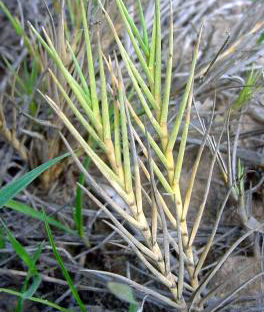Saltgrass
Distichlis spicata
Saltgrass is a perennial halophyte. The subspecies, Distichlis spicata spicata (L) Greene, is a California native that tolerates the alkali soil in the marsh plains and salt pans of coastal saltmarshes.

Credit: Michael Charter. Used with permission.
SPECIES IN DETAIL
Saltgrass
Distichlis spicata
CONSERVATION STATUS: Safe for Now
CLIMATE CHANGE: Not Applicable
At the Aquarium
Our plants, located in the Shorebird Sanctuary, were donated by the Stewards of the Los Cerritos Wetlands located in Long Beach, California.
Geographic Distribution
Most of western North America including coastal California. Also Central and South America.
Habitat
These plants plant prefers the middle zone or marsh plain of the saltmarsh. It is frequently found growing just above pickleweed, Salicornia virginica.
Physical Characteristics
Saltgrass plants usually form a low dense mat ground cover of sprawling, large, patchy colonies that are about 20 to 30 cm (8 to 12 in) tall. The plants can be somewhat erect. This grass has stiff, narrow, pointed blades that alternate up the stem, growing away from the base at an angle. The blades are 2.54 to 15.2 (1-6 in) long and about 6.3 mm (0.25 in) wide.
They are blue-green in color and often coated with salt crystals. Rhizomes are scaly and yellowish. Small purple or straw-colored flowers appear in the spring. The seeds are smooth and 1.5 mm (0.06 in) long.
Diet
Saltgrass obtains its nutrients through photosynthesis.
Reproduction
Reproduction is asexual and sexual. The plants primarily spread by vegetative propagation year-round by forming new clones from its extensive underground rhizome system. The rhizomes extend out and produce new sprouts of the original plant.
Male and females flowers are found on different flowers. Male spikelets (short branches) are thick and yellow; whereas female spikelets are greener and more membranous. Flowers bloom from April to July. Pollen is spread either by self-fertilization or is transferred by wind or water to the wavy stigmas of female plants that catch the pollen. Because of the specific requirements of this plant for seed germination—extremely high temperature, low salinity, and moist soil—success of seed germinating is low.
Adaptation
Saltgrass is a salt excretor. Its roots take in seawater and saltwater is pumped out through special pores in the leaves. The sun evaporates the water and the salt crystals left behind become visible on the grass blades.
Hollow tubes in the plant’s stems pass oxygen from the leaves down to the underground rhizomes.
Conservation
Saltgrass is a food source for various species of ducks and geese and it provides a nesting site for birds and habitat for small mammals such as mice and voles.
Because of its thick system of rhizomes and roots, it is being used extensively in saltmarsh restoration projects to stabilize unconditioned soil and counteract erosion.
Special Notes
A salt extruder, saltgrass is being tested for abilities to restore salt soils so they can be used for agriculture. Ironically, because of its spreading mat growth the state of Nebraska lists saltgrass as a noxious weed.
Distichlis spicata is the only host plant for the larvae of the wandering skipper butterfly, Panoquina errans.
SPECIES IN DETAIL | Print full entry
Saltgrass
Distichlis spicata
CONSERVATION STATUS: Safe for Now
CLIMATE CHANGE: Not Applicable
Our plants, located in the Shorebird Sanctuary, were donated by the Stewards of the Los Cerritos Wetlands located in Long Beach, California.
Most of western North America including coastal California. Also Central and South America.
These plants plant prefers the middle zone or marsh plain of the saltmarsh. It is frequently found growing just above pickleweed, Salicornia virginica.
Saltgrass plants usually form a low dense mat ground cover of sprawling, large, patchy colonies that are about 20 to 30 cm (8 to 12 in) tall. The plants can be somewhat erect. This grass has stiff, narrow, pointed blades that alternate up the stem, growing away from the base at an angle. The blades are 2.54 to 15.2 (1-6 in) long and about 6.3 mm (0.25 in) wide.
They are blue-green in color and often coated with salt crystals. Rhizomes are scaly and yellowish. Small purple or straw-colored flowers appear in the spring. The seeds are smooth and 1.5 mm (0.06 in) long.
Saltgrass obtains its nutrients through photosynthesis.
Reproduction is asexual and sexual. The plants primarily spread by vegetative propagation year-round by forming new clones from its extensive underground rhizome system. The rhizomes extend out and produce new sprouts of the original plant.
Male and females flowers are found on different flowers. Male spikelets (short branches) are thick and yellow; whereas female spikelets are greener and more membranous. Flowers bloom from April to July. Pollen is spread either by self-fertilization or is transferred by wind or water to the wavy stigmas of female plants that catch the pollen. Because of the specific requirements of this plant for seed germination—extremely high temperature, low salinity, and moist soil—success of seed germinating is low.
Saltgrass is a salt excretor. Its roots take in seawater and saltwater is pumped out through special pores in the leaves. The sun evaporates the water and the salt crystals left behind become visible on the grass blades.
Hollow tubes in the plant’s stems pass oxygen from the leaves down to the underground rhizomes.
Saltgrass is a food source for various species of ducks and geese and it provides a nesting site for birds and habitat for small mammals such as mice and voles.
Because of its thick system of rhizomes and roots, it is being used extensively in saltmarsh restoration projects to stabilize unconditioned soil and counteract erosion.
A salt extruder, saltgrass is being tested for abilities to restore salt soils so they can be used for agriculture. Ironically, because of its spreading mat growth the state of Nebraska lists saltgrass as a noxious weed.
Distichlis spicata is the only host plant for the larvae of the wandering skipper butterfly, Panoquina errans.

